Catholic Schools Week Supplement
Teachers: The heart and soul of Catholic education
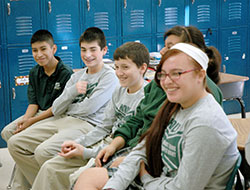
Bishop Chatard High School teacher Robin Kontor, right, coordinated the Indianapolis school’s effort to prepare and deliver Thanksgiving meals for 450 people on Nov. 28. Kontor’s husband, Jeff, left, was also among the students, faculty, parents and other volunteers who prepared, packaged and delivered the meals. (Submitted photo)
By John Shaughnessy
Parents are often considered their child’s first teachers.
At the same time, most parents whose children attend Catholic schools respect and appreciate the care, hard work and dedication that mark the way that Catholic school teachers educate children.
Kathleen Bear, Susan Huber, Gerard Striby and Denise Wilson are among the teachers who serve students in Catholic schools throughout the archdiocese. All four were among the 2012-2013 finalists for the St. Theodora Guérin Excellence in Education Award, the highest honor for a Catholic educator in the archdiocese.
As part of the selection process, they each had to answer a series of questions ranging from “Describe what quality Catholic education looks like to you” to “Describe one of your most rewarding teaching experiences.”
Here are some of their stories and experiences that define them as teachers and represent the influence of their peers throughout the archdiocese.
A powerful moment of goodness
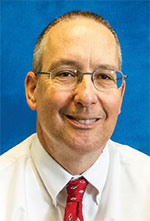 Gerard Striby understands that the best lessons students get about faith don’t always occur in the classroom.
Gerard Striby understands that the best lessons students get about faith don’t always occur in the classroom.
Sometimes, those lessons happen on senior retreats or during service projects—including one memorable mission trip to rebuild a house in an impoverished area in Charleston, West Virginia.
“On this particular trip, we were trying to put drywall and flooring in a very small house, to allow a young husband and his expectant wife to move in as soon as possible,” recalls Striby, who teaches religious studies at Roncalli High School in Indianapolis. “While I realized that the house would not be ready in the four days we worked, we wanted to get them as close as possible to moving in.
“By the end of the week, it became obvious that both time and money were running out, and we would not be able to complete our goals. When I conveyed that to the students on the final work day, they got together and took up a collection among their peers to purchase more drywall and other supplies.”
Then they told Striby that they wanted to skip their plans for dinner and fun that night so they could concentrate on getting the house ready for the couple.
“They did all of this completely on their own, without any suggestion from me or other adults,” Striby notes. “We took our last trip to Lowes and worked until 11 that night to complete the work.”
It’s a moment that has remained powerful for Striby.
“First of all, it was yet another reminder to me of the inherent goodness in all my students, even though they may sometimes frustrate me. I try to recognize that each one of my students has wonderful gifts to offer others.
“If given the opportunity, the vast majority will always meet and often exceed my expectations. I try my very best now not to underestimate my students.”
The importance of living the faith
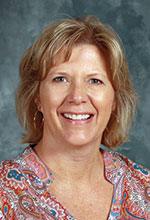 One of Denise Wilson’s most rewarding experiences as a Catholic school teacher involved a new fifth-grade student who was non-Catholic—a student who was dealing with a family tragedy.
One of Denise Wilson’s most rewarding experiences as a Catholic school teacher involved a new fifth-grade student who was non-Catholic—a student who was dealing with a family tragedy.
“He was new to our school, new to our city, and new to our faith,” recalls Wilson, now a master teacher and assistant principal at St. Barnabas School in Indianapolis.
“Tragically, his father passed away shortly after school had begun that year. While he was a very bright student with a kind and loving heart, he struggled that year with life in general. However, he was always very interested and involved in our religious discussions.”
The boy became so interested in those talks that he asked his mother if he could go to Sunday Mass at St. Barnabas Church instead of the church service that they regularly attended.
“On many Sundays, his mom willingly dropped him off at St. Barnabas for Mass and then she would drive to her own church,” Wilson notes.
It all led the boy to want to become a Catholic.
“He went through the Rite of Christian Initiation for Adults program and was baptized a Catholic while he was a student here at St. Barnabas,” Wilson says. “I am just so proud that as a community of Catholics, we lived a life here at St. Barnabas that professed a love and faith that he wanted to be part of.
“As a [extraordinary] minister [of holy Communion], I would notice that he would so proudly raise his hands to accept the body of Christ, and it meant so much to me to put it there. I use this story when discussing with students about how important it is to live your faith. You never know who may be watching and learning.”
The challenge of choices
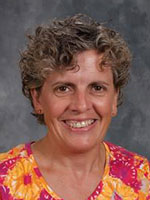 Kathleen Bear talks daily to her second-grade students about whether they are following the example of Jesus.
Kathleen Bear talks daily to her second-grade students about whether they are following the example of Jesus.
“I am constantly asking them if they are doing the right thing,” says Bear, who teaches at Pope John XXIII School in Madison. “In class, we talk about making good choices based on what God would want us to do.
“When we are studying science, we talk about God’s creations. In reading, when a character has made a poor choice, I will ask the students if that character has made the choice based on what God would want us to do.
“Integrating Catholic teachings and doctrine is something that most of the teachers in the Catholic system probably don’t even consciously think about most of the time. It’s just something that we do because we feel that strongly about our faith. It has certainly made me think about my choices outside of school as well.”
Keeping Christ as the focus
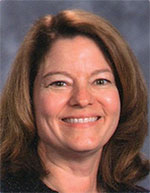 As she works with her teenaged students, Susan Huber views every day of teaching in a Catholic school as a blessing from God.
As she works with her teenaged students, Susan Huber views every day of teaching in a Catholic school as a blessing from God.
“I see beyond the teenage angst they are going through, and I see God’s work in progress,” says Huber, a teacher in the junior high at St. Anthony of Padua School in Clarksville. “I believe my students are meant to touch the lives of others, and what they experience in my classroom will carry out to their families, neighborhoods and communities.”
That faith in God—and in her students—combined to create one of her best teaching experiences when she planned a spiritual retreat for the eighth-grade students, moving it from the spring to the fall.
“The fall retreat allowed the class to see Christ as their focus for the rest of the year,” Huber recalls. “We studied the manger scene and the significance of each member, created a piece of religious art to take home, and planted seeds, literally and figuratively, to plan for our growth in faith.”
The retreat also led to a close bond among the students that continued throughout the year in the classroom.
“Trust was more apparent in discussions,” Huber says. “Acts of kindness and friendship were more evident. I was reminded that if I begin with Christ, everything else is better and easier.” †

 Gerard Striby understands that the best lessons students get about faith don’t always occur in the classroom.
Gerard Striby understands that the best lessons students get about faith don’t always occur in the classroom. One of Denise Wilson’s most rewarding experiences as a Catholic school teacher involved a new fifth-grade student who was non-Catholic—a student who was dealing with a family tragedy.
One of Denise Wilson’s most rewarding experiences as a Catholic school teacher involved a new fifth-grade student who was non-Catholic—a student who was dealing with a family tragedy. Kathleen Bear talks daily to her second-grade students about whether they are following the example of Jesus.
Kathleen Bear talks daily to her second-grade students about whether they are following the example of Jesus. As she works with her teenaged students, Susan Huber views every day of teaching in a Catholic school as a blessing from God.
As she works with her teenaged students, Susan Huber views every day of teaching in a Catholic school as a blessing from God.